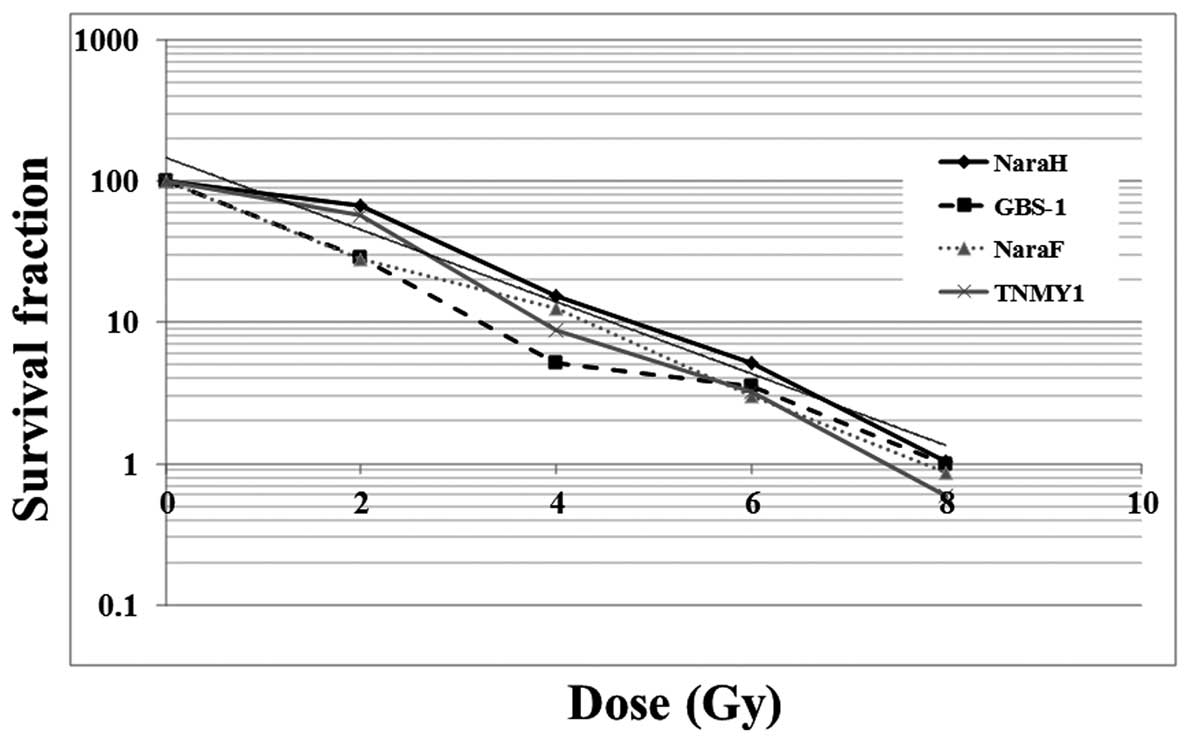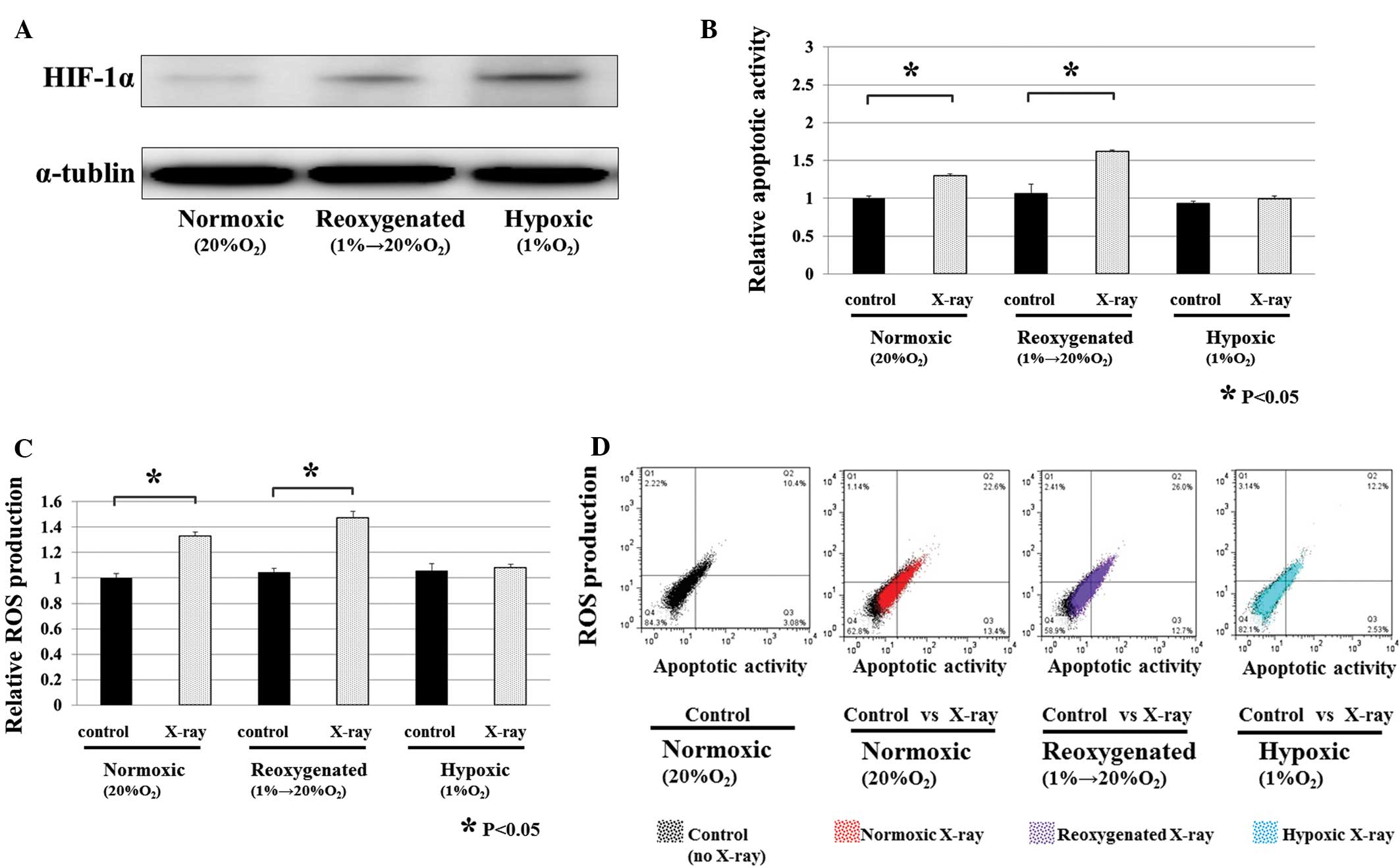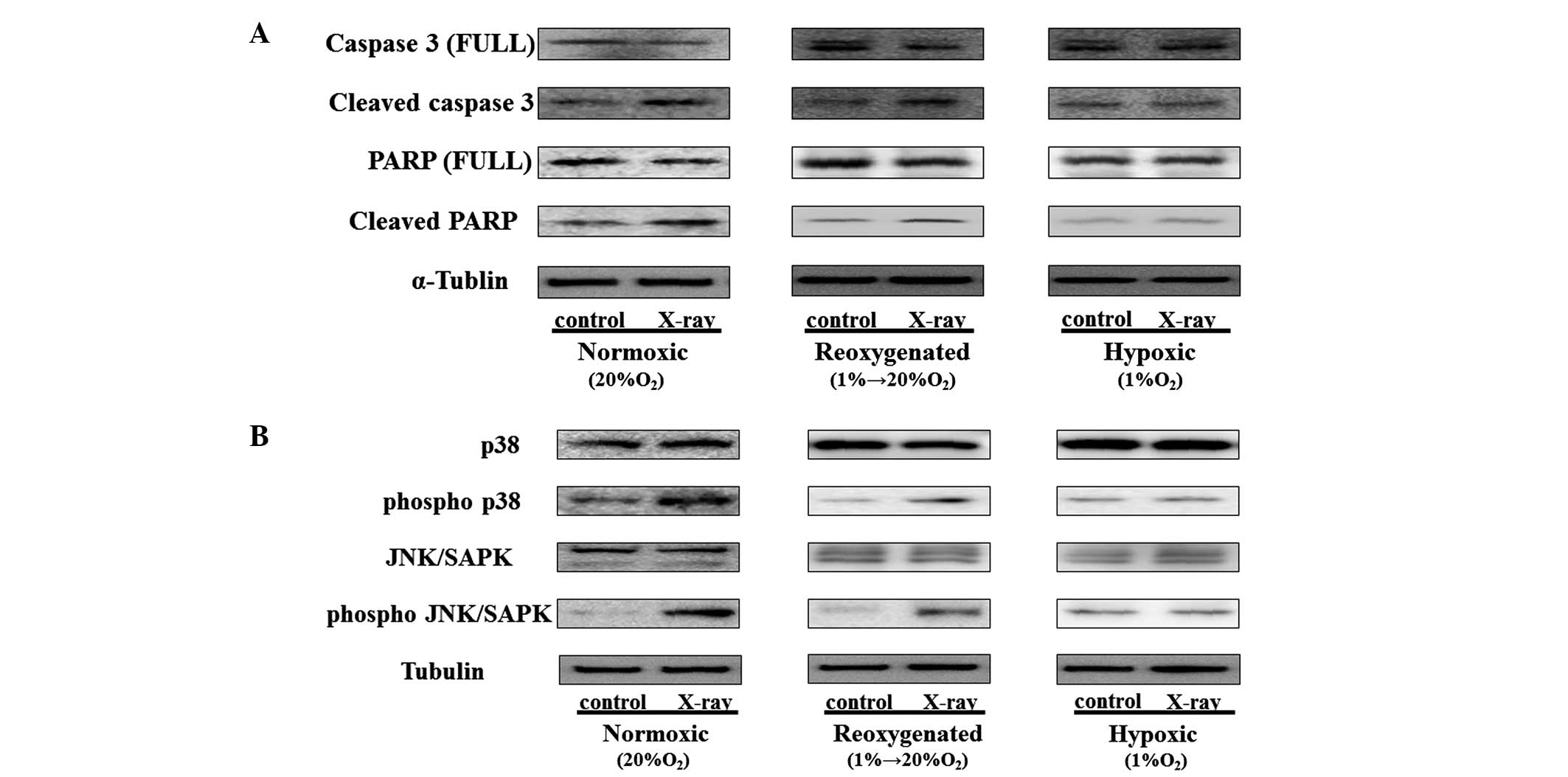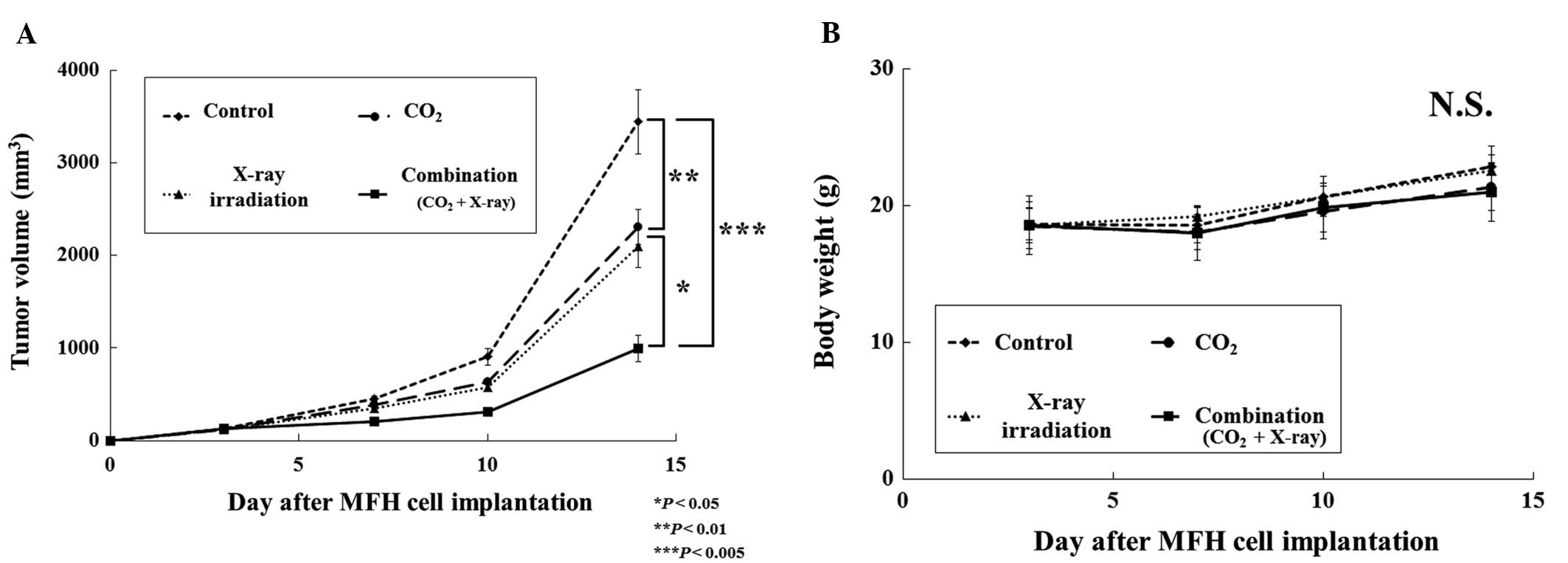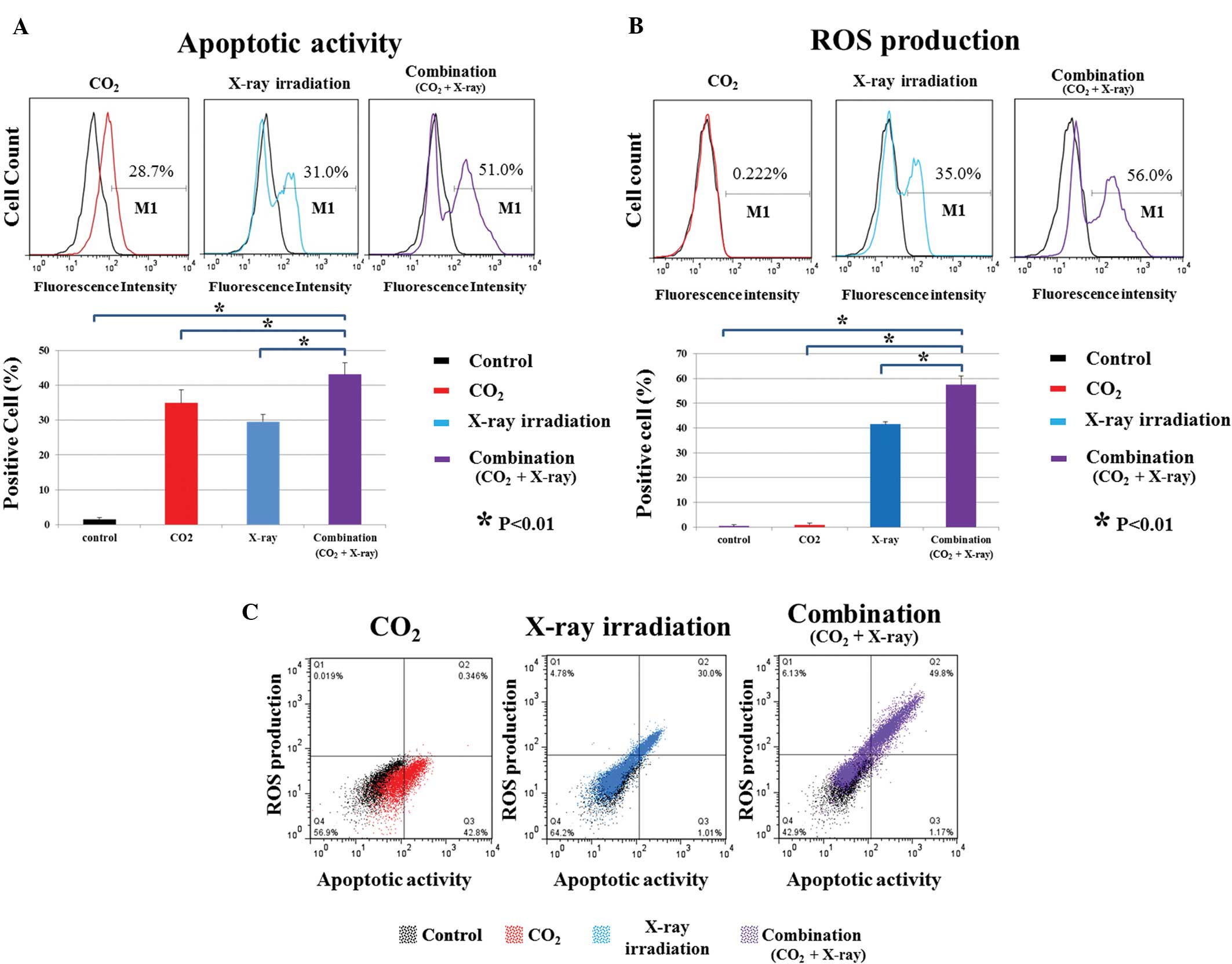Transcutaneous application of CO2 enhances the antitumor effect of radiation therapy in human malignant fibrous histiocytoma
- Authors:
- Published online on: May 29, 2014 https://doi.org/10.3892/ijo.2014.2476
- Pages: 732-738
Abstract
Introduction
Malignant fibrous histiocytoma (MFH), which has recently been classified as undifferentiated pleomorphic sarcoma (UPS), is the most common soft tissue sarcoma in late adult life. Advances in the treatment of MFH have led to multidisciplinary treatments, including surgery, chemotherapy and radiation therapy. However, the prognosis of patients with the disease is still extremely poor because of local recurrence and distant metastases (1).
Tumor hypoxia is a common feature of malignant tumors, and contributes to their malignant progression, distant metastasis and resistance to radiation therapy and chemotherapy (2). The relevance of tumor oxygenation to radiocurability was first proposed by Gray et al (3). Since the role played by oxygenation in radiosensitivity has been recognized, several strategies including high-oxygen-content gas breathing, radiosensitizers, and hypoxic cytotoxins, have been developed to overcome hypoxia-mediated radioresistance (4). However, with these strategies an increased tumor control rate is often accompanied by more severe side effects (5,6).
Carbon dioxide (CO2) therapy in the form of a carbonated spa has been historically used in Europe as an effective treatment for cardiac diseases and skin problems (7,8). It has been suggested that the therapeutic effects of CO2 may be due to an increase in blood flow and microcirculation, nitric oxide-dependent neocapillary formation, and a partial increase in O2 pressure in the local tissues known as the Bohr effect (7–9). We have previously demonstrated that the transcutaneous application of CO2 increased local O2 pressure in treated tissues, potentially causing an ‘artificial Bohr effect’ (10), and we have also shown that the transcutaneous CO2 system has antitumor effects; it can also enhance chemosensitivity through the improvement of hypoxia in human MFH xenografts (11,12). In murine osteosarcoma cells, the transcutaneous CO2 system has also been reported to reduce hypoxic conditions (13). Based on these findings, we hypothesized that the transcutaneous application of CO2 could enhance the antitumor effects of radiation therapy through the improvement of hypoxia in tumor tissues.
In the presence of oxygen, ionizing radiation generates reactive oxygen species (ROS) such as superoxide radicles, hydrogen peroxide and hydroxyl radicals; these show high reactivity to a variety of cellular macromolecules (14). ROS are implicated in playing crucial roles in cellular responses to radiation therapy (14), and they also regulate a broad array of signal transductions that control various biological processes including apoptosis (15). Mitogen-activated protein kinases (MAPKs) include three major kinases: extracellular signal-regulated kinase (ERK), p38 kinase, and c-Jun N-terminal kinase/stress-activated protein kinase (JNK/SAPK). Among these kinases, p38 and JNK/SAPK are mainly activated by extracellular stresses such as irradiation and inflammatory cytokines (16). Recent studies have shown that activation of p38 and JNK/SAPK contributes to ROS-induced apoptosis (17,18). Hypoxia is thought to induce apoptotic resistance by suppression of caspase-3 and JNK/SAPK in cells (17).
Additionally, it is well documented that ROS are involved in the induction of apoptosis in γ-irradiated cancer cells as well as normal cells (18). However, the effects of hypoxia on radiation induced apoptotic activities in MFH cells are poorly understood, and the relationship between ROS production and the induction of apoptosis by radiation therapy in MFH has not been reported. In the current study, we examined the in vitro effects of altering the oxygen conditions on X-ray irradiation induced cell apoptosis and ROS production, and the activation of ROS-mediated and apoptosis related proteins in MFH cells. We also utilized a murine model of human MFH to examine the antitumor effects of combined treatment with CO2 therapy and X-ray irradiation. Additionally, we investigated the effects of transcutaneous CO2 application on radiation therapy in terms of ROS production, the induction of apoptosis, and the activation of ROS-mediated and apoptosis- related proteins in human MFH.
Materials and methods
Cell cultures
Four human MFH cell lines (Nara-H, TNMY-1, Nara-F and GBS-1) were used in our studies. Nara-H and Nara-F cell lines were obtained from ScienStuff Co. (Nara, Japan) (19). TNMY-1 was previously established in our laboratory (20). GBS-1 was obtained from ACTT (21). Cells were grown in culture medium consisting of Dulbecco’s modified Eagle’s medium (DMEM: Sigma-Aldrich Co., St. Louis, MO, USA) supplemented with 10% (v/v) fetal bovine serum (FBS: Sigma-Aldrich Co.) and 100 U/ml penicillin/streptomycin solution (Sigma-Aldrich Co.). Cells were maintained at 37°C in a humidified 5% CO2 atmosphere.
X-ray irradiation
X-ray irradiation was performed at a dose rate of 0.64–0.66 Gy/min using a 150 kV X-ray generator unit operating at 5 mA with an external 0.1 mm aluminum filter (MBR-1505122: Hitachi Medical Co., Tokyo, Japan).
Colony formation assay
We performed colony formation assays of X-ray irradiated MFH cells to evaluate the response of the cells to X-ray irradiation. Four MFH cell lines were treated by X-irradiation at five different doses (0, 2, 4, 6 and 8 Gy). Immediately after X-irradiation, cells were trypsinized and seeded at a density of 100–1000 cells/well in 6-well plates, and incubated in a humidified atmosphere of 5% CO2 at 37°C. After 2 weeks of incubation, cells were stained with Giemsa and the number of colonies was counted.
In vitro experiments
To investigate the effects of altering the oxygen conditions on the sensitivity of human MFH cells to X-ray irradiation, Nara-H cells were incubated for 48 h under one of three different oxygen conditions: normoxic (20% O2, 5% CO2, and 75% N2), hypoxic (1% O2, 5% CO2, and 94% N2), or reoxygenated conditions, as previously described (12). Under reoxygenated conditions, cells were incubated under normoxia for 24 h followed by 24 h of incubation under hypoxic conditions, as previously described (12). Hypoxic conditions were also obtained by exposing Nara-H cells to CoCl2, a well known chemical used to induce of hypoxia (23). In particular, the CoCl2 powder was dissolved in DMEM and the resulting solution was filtered and then added to cell cultures at final concentration of 150 μl (23). In the reoxygenated condition, the medium without CoCl2 (normoxic condition) was replaced after 24 h under CoCl2 hypoxic conditions. We also examined the effects of altering the oxygen conditions on the sensitivity of human MFH cells to X-ray irradiation. After 24 h of incubation in one of three different oxygen conditions X-ray irradiation (3.2 Gy) was performed, and incubation was continued for a further 24 h.
Animal models
Male athymic BALB/c nude mice, aged 5–8 weeks, were obtained from CLEA Japan Inc. (Tokyo, Japan). All animal experiments were approved by the Institutional Animal Care and Use Committee of Kobe University Graduate School of Medicine, and were performed in accordance with the Guidelines for Animal Experimentation of Kobe University Graduate School of Medicine, and Kobe University Animal Experimentation Regulations (permission number: P110201). To create a murine model of human MFH, Nara-H cells were implanted into the dorsal subcutaneous area of male athymic BALB/c nude mice at a concentration of 4.0×106 cells in 500 μl PBS as previously described (11). Transcutaneous application of CO2 was carried out as previously described (11,12). Each treatment was performed for 10 min. Control animals were treated in a similar manner by replacing CO2 with room air.
In vivo MFH tumor studies
We examined the in vivo effects of combined treatments using transcutaneous CO2 therapy and X-ray irradiation. Mice were randomly divided into four groups: the control group (n=6), the CO2 group (n=6), the X-ray irradiation group (n=6), and the combination (CO2 and X-ray irradiation) group (n=6). Treatments commenced 3 days after MFH cell implantation, and were performed twice weekly for 2 weeks, four times in total. X-ray irradiation was given immediately after CO2 or room air treatment at a dose of 0.8 Gy for each treatment (3.2 Gy in total). Mouse body weight and tumor volume were monitored twice weekly until the end of treatment. Tumor volume (V) was calculated as previously described (11,12). All tumors were excised at the end of treatment and apoptotic activity, ROS production and their relationship in tumor tissue was assessed.
Flow cytometric analysis
Flow cytometry was performed using a FACS Calibur™ flow cytometer (BD Pharmingen, Franklin Lakes, NJ, USA) as previously described (11,12). We evaluated apoptotic activity in MFH cells by means of the DNA fragmentation assay using the Apo-Direct kit according to the manufacturer’s protocol (BD Pharmingen). To evaluate ROS production we used 2′, 7′-dichlorofluorescin diacetate (DCFH-DA; Molecular Probes, Invitrogen, Carlsbad, CA, USA) as an indicator (22).
Immunoblot analysis
Immunoblot analysis was performed as previously described (11,12). We used the following antibodies: anti-human caspase-3 antibody (1:1000) (Cell Signaling Technology, Danvers, MA, USA), anti-human PARP antibody (1:1000) (Cell Signaling Technology), anti-human p38 antibody (1:1000) (Cell Signaling Technology), anti-human phospho p38 antibody (1:1000) (Cell Signaling Technology), anti-human JNK/SAPK antibody (1:1000) (Cell Signaling Technology), anti-human phospho-JNK/SAPK antibody (1:1000) (Cell Signaling Technology), and anti-human α-tubulin antibody (1:2000) (Sigma-Aldrich Co.).
Statistical analysis
All experiments were performed independently at least three times, and data are presented as the mean ± standard error (SE) unless otherwise indicated. Differences between groups were evaluated using a two-tailed Student’s t-test, and also using ANOVA with the post hoc test to compare for continuous values. All tests were considered significant when the P-value was <0.05.
Results
Effects of oxygen conditions on X-ray induced apoptosis and ROS production in human MFH cells in vitro
First, we performed colony formation assays using four MFH cell lines (Nara-H, Nara-F, TNMY-1, and GBS-1) that were treated with various doses of X-rays to evaluate the response of the cells to radiation therapy. The number of MFH cell colonies decreased in a dose-dependent manner after X-ray irradiation. Nara-H cells were the most radioresistant of the four MFH cell lines; a 50% decrease in colony formation was achieved at a dose of 3.2 Gy (Fig. 1).
Next, we studied the effects of altering the oxygen conditions on X-ray induced cell apoptosis in Nara-H cells in vitro. Three different oxygen conditions were used as previously described (12). Apoptotic activity and ROS production in the cells was assessed using flow cytometric analysis and immunoblotting at 24 h after X-ray irradiation (3.2 Gy) under three different oxygen conditions. After 48 h of incubation, the expression of HIF-1α protein was strongly increased in cells under hypoxic conditions, whereas the expression of HIF-1α protein was decreased in cells cultured under reoxygenated conditions (Fig. 2A). It was found that both apoptotic activity and ROS production were increased by X-ray irradiation in reoxygenated and normoxic conditions (P<0.05) (Fig. 2B and C). In addition, there was a correlation between apoptotic activity and ROS production (Fig. 2D). However, neither the apoptotic activity or ROS production was increased by X-ray irradiation under hypoxic conditions (Fig. 2B and C). Hypoxic conditions were also stimulated by exposure to CoCl2, a well known chemical used to induce hypoxia (23). These results were consistent with those obtained after the chemical induction (CoCl2) of three different oxygen conditions (data not shown).
Immunoblot analyses revealed that the cleavage of both caspase-3 and PARP was strongly increased in X-ray irradiated MFH cells under normoxic and reoxygenated conditions (Fig. 3A). It also revealed that the expression of phosphorylated forms of both of the pro-apoptotic signaling molecules, p38 and JNK/SAPK, were increased after X-ray irradiation, while the expression of total p38 and JNK/SAPK were not changed under normoxic and reoxygenated conditions (Fig. 3B); however, under hypoxic conditions the expression of protein was not changed (Fig. 3A and B). These results were corroborated by chemical induction of three different oxygen conditions, achieved by exposure to CoCl2 (data not shown). They strongly indicated that the improvement in hypoxic conditions enhanced X-ray irradiation-induced MFH cell apoptosis and ROS production in vitro.
Effects of the transcutaneous application of CO2 with X-ray irradiation on apoptosis and ROS production in human MFH xenografts
To examine the effect of transcutaneous CO2 therapy on X-ray irradiation in vivo, we used the Nara-H cell line; the response of MFH tumors to this combined treatment was evaluated. We observed a significant decrease in tumor volume in the CO2, X-ray irradiation and combination groups when compared with the control group. At the end of the experiment, tumor volume in the combination group (CO2 and X-ray irradiation) was reduced to 28, 42 and 47% of that in the control, CO2 alone, and X-ray irradiation alone groups, respectively (Fig. 4A). No significant differences in body weight were observed among the groups (Fig. 4B). FACS analyses showed that apoptotic activity and ROS production in the combination group were strongly increased relative to those in the control, CO2 alone, and X-ray irradiation alone groups (P<0.01) (Fig. 5A and B). Transcutaneous CO2 therapy alone did not affect ROS production (Fig. 5B). There was a correlation between apoptotic activity and ROS production in the X-ray irradiation alone and combination groups (Fig. 5C). In addition, we evaluated the effect of combined treatment with transcutaneous CO2 therapy and X-ray irradiation on the ROS-mediated signaling pathway. Immunoblot analyses showed that the expressions of the cleavage of caspase-3, and PARP and phosphorylated forms of both p38 and JNK/SAPK, were strongly increased with decreasing HIF-1α expression in tumors that were treated by combined treatment relative to the other treatment groups (Fig. 6). These results indicated that combined treatment with transcutaneous CO2 therapy and X-ray irradiation resulted in a significant antitumor effect in the human MFH xenografts; in addition, transcutaneous CO2 therapy enhanced the antitumor effect of X-ray irradiation with an improvement in hypoxic conditions through the activation of the ROS-mediated signaling pathway.
Discussion
The presence of hypoxic cells in solid tumors has been well documented, and tumor hypoxia is believed to be a major cause of clinical radioresistance in various cancer types including MFH (24–26). Previous studies dating back more than 50 years have shown that well oxygenated cells are three times more radiosensitive than hypoxic cells (3, 27). Based on these strategies, several studies have been performed using hyperbaric oxygen (28) and the transfusion of red blood cells (29) to radiosensitize tumor tissues. However, these therapies have proven to be of limited benefit and can be harmful to patients (5,6).
We have previously demonstrated in human MFH xenografts that the transcutaneous application of CO2 increased the local O2 pressure in treated tissue (10), and that CO2 therapy enhanced chemosensitivity because of a reduction in hypoxia (11). We have also previously reported that CO2 therapy decreased the metastatic potential of murine osteosarcoma (13). Therefore, we hypothesize that our transcutaneous CO2 therapy can improve the response of MFH cells to radiation therapy. There is little evidence to support a possible relationship between CO2 therapy and radiosensitivity. Carbogen, a hyperoxic gas containing a small fraction of CO2, has been reported as being a more effective and less toxic radiosensitizer (30). Carbogen was first used clinically as a radiosensitizer in the early 1960s, and has now been reintroduced into the clinic following the work of Rojas et al (30). These authors demonstrated the effectiveness of simple normobaric oxygen and carbogen breathing in an animal tumor model (30). The gas has been shown to improve tumor oxygenation by increasing the amount of dissolved oxygen in plasma, and to increase tumor radiosensitivity (31). In the current study, we demonstrated that the transcutaneous application of CO2 enhanced the antitumor effects of X-ray irradiation in human MFH xenografts, with no observable side effects.
In addition, we found that a possible mechanism involved in the induction of MFH cell death after combined treatment with transcutaneous CO2 therapy and X-ray irradiation, may depend on ROS production and the activation of ROS-mediated signaling pathways. In the presence of oxygen, ionizing radiation acts on biochemical systems via ROS production (32). ROS play a major role in radiation-induced cellular damage, and can induce apoptosis through activation of a pro-apoptosis pathway (33). In the current in vivo study, increased apoptotic activity along with increased ROS production were observed in the combination group (CO2 and X-ray irradiation), while ROS production was not increased by transcutaneous CO2 therapy alone. The results suggest that transcutaneous CO2 therapy can enhance radiation-induced ROS production, but cannot increase ROS production by itself. Our previous study revealed that transcutaneous CO2 therapy improved hypoxic conditions in MFH tumor tissues (11). Therefore, we speculate that transcutaneous CO2 therapy can enhance ROS production in X-ray irradiated MFH tumors through increased local oxygenation. Pro-apoptotic signaling pathways, such as p38 MAPK and JNK/SAPK, are stimulated by ROS production and induce cell apoptosis (34,35). It has been reported that p38 MAPK was efficiently activated by a low dose of X-rays (36), and radiation-induced upregulation of MAPKs and JNK/SAPK has also been reported in cultured cells (37,38). However, radiation-induced upregulation of MAPKs or JNK/SAPK in musculoskeletal tumors has not been studied. In the present study, we found that p38 and JNK/SAPK were activated in human MFH tumors after X-ray irradiation in reoxygenated conditions in vitro; in addition, the activation of both p38 and JNK/SAPK were strongly increased with the improvement in hypoxic conditions in xenograft bearing mice that were treated using combined treatment with transcutaneous CO2 therapy and X-ray irradiation, relative to CO2 therapy alone or X-ray irradiation alone. These results suggest that the mechanism of enhancement of the antitumor effects of radiation therapy by transcutaneous CO2 therapy involves ROS production and ROS-mediated activation of p38 and JNK/SAPK signaling pathways. However, the ROS-related mehcanisms require further study.
In conclusion, the findings of the current study strongly imply that CO2 therapy can enhance the antitumor effect of radiation therapy for human MFH by increasing ROS production as a consequence of reduced tumor hypoxia, with no observable side effects. We believe that the current study is the first to reveal the effect of transcutaneous CO2 therapy on the radiocurability of a human sarcoma xenograft tumor, and could represent a potent therapeutic breakthrough in the treatment of radioresistant human malignancies.
Acknowledgements
We thank Minako Nagata, Maya Yasuda and Kyoko Tanaka for their expert technical assistance. Mr. T. Ueha reports personal fees from NeoChemir Inc., the others authors report grants and non-financial support from NeoChemir Inc., during the conduct of the study. In addition, Kobe University and NeoChemir Inc. have a patent Antitumor Agent Containing Carbon Dioxide as Active Ingredient issued to WO/2012/133114. This study was supported by JSPS KAKENHI 24659565 grant number.
References
|
Le DV, Coindre JM, Leroux A, et al: Prognostic factors for patients with localized primary malignant fibrous histiocytoma: a multicenter study of 216 patients with multivariate analysis. Cancer. 77:1823–1830. 1996. View Article : Google Scholar : PubMed/NCBI | |
|
Ruan K, Song G and Ouyang G: Role of hypoxia in the hallmarks of human cancer. J Cell Biochem. 107:1053–1062. 2009. View Article : Google Scholar : PubMed/NCBI | |
|
Gray LH, Conger AD, Ebert M, Hornsey S and Scott OC: The concentration of oxygen dissolved in tissues at the time of irradiation as a factor in radiotherapy. Br J Radiol. 26:638–648. 1953. View Article : Google Scholar : PubMed/NCBI | |
|
Moeller BJ, Richardson RA and Dewhirst MW: Hypoxia and radiotherapy: opportunities for improved outcomes in cancer treatment. Cancer Metastasis Rev. 26:241–248. 2007. View Article : Google Scholar : PubMed/NCBI | |
|
Bennett M, Feldmeier J, Smee R and Milross C: Hyperbaric oxygenation for tumour sensitisation to radiotherapy. Cochrane Database Syst Rev. 19:CD0050072005. | |
|
Henke M, Laszig R, Rube C, et al: Erythropoietin to treat head and neck cancer patients with anaemia undergoing radiotherapy: randomised, double-blind, placebo-controlled trial. Lancet. 362:1255–1260. 2003. View Article : Google Scholar | |
|
Resch KL and Just U: Possibilities and limits of CO2balneotherapy. Wien Med Wochenschr. 144:45–50. 1994.(In German). | |
|
Hartmann BR, Bassenge E and Pittler M: Effect of carbon dioxide-enriched water and fresh water on the cutaneous microcirculation and oxygen tension in the skin of the foot. Angiology. 48:337–343. 1997. View Article : Google Scholar : PubMed/NCBI | |
|
Riggs A: The nature and significance of the Bohr effect in mammalian hemoglobins. J Gen Physiol. 43:737–752. 1960. View Article : Google Scholar : PubMed/NCBI | |
|
Sakai Y, Miwa M, Oe K, et al: A novel system for transcutaneous application of carbon dioxide causing an ‘artificial Bohr effect’ in the human body. PloS One. 6:e241372011.PubMed/NCBI | |
|
Onishi Y, Kawamoto T, Ueha T, et al: Transcutaneous application of carbon dioxide (CO2) enhances chemosensitivity by reducing hypoxic conditions in human malignant fibrous histiocytoma. J Cancer Sci Ther. 4:174–181. 2012. | |
|
Onishi Y, Kawamoto T, Ueha T, et al: Transcutaneous application of carbon dioxide (CO2) induces mitochondrial apoptosis in human malignant fibrous histiocytoma in vivo. PloS One. 7:e491892012.PubMed/NCBI | |
|
Harada R, Kawamoto T, Ueha T, et al: Reoxygenation using a novel CO2 therapy decreases the metastatic potential of osteosarcoma cells. Exp Cell Res. 319:1988–1997. 2013.PubMed/NCBI | |
|
Tominaga H, Kodama S, Matsuda N, Suzuki K and Watanabe M: Involvement of reactive oxygen species (ROS) in the induction of genetic instability by radiation. J Radiat Res. 45:181–188. 2004. View Article : Google Scholar : PubMed/NCBI | |
|
Engel RH and Evens AM: Oxidative stress and apoptosis: a new treatment paradigm in cancer. Front Biosci. 11:300–312. 2006. View Article : Google Scholar : PubMed/NCBI | |
|
Kyriakis JM and Avruch J: Mammalian mitogen-activated protein kinase signal transduction pathways activated by stress and inflammation. Physiol Rev. 81:807–869. 2001.PubMed/NCBI | |
|
Samuni AM, Kasid U, Chuang EY, et al: Effects of hypoxia on radiation-responsive stress-activated protein kinase, p53, and caspase 3 signals in TK6 human lymphoblastoid cells. Cancer Res. 65:579–586. 2005.PubMed/NCBI | |
|
Mishra KP: Cell membrane oxidative damage induced by gamma-radiation and apoptotic sensitivity. J Environ Pathol Toxicol Oncol. 23:61–66. 2004. View Article : Google Scholar : PubMed/NCBI | |
|
Kiyozuka Y, Nakagawa H, Uemura Y, et al: Novel cell lines established from a human myxoid malignant fibrous histiocytoma arising in the uterus. Cancer Genet Cytogenet. 127:7–15. 2001. View Article : Google Scholar : PubMed/NCBI | |
|
Nakatani T, Marui T, Yamamoto T, et al: Establishment and characterization of cell line TNMY1 derived from human malignant fibrous histiocytoma. Pathol Int. 51:595–602. 2001. View Article : Google Scholar : PubMed/NCBI | |
|
Fang Z, Mukai H, Nomura K, et al: Establishment and characterization of a cell line from a malignant fibrous histiocytoma of bone developing in a patient with multiple fibrous dysplasia. J Cancer Res Clin Oncol. 128:45–49. 2002. View Article : Google Scholar : PubMed/NCBI | |
|
Sasaki H, Takayama K, Matsushita T, et al: Autophagy modulates osteoarthritis-related gene expressions in human chondrocytes. Arthritis Rheum. 64:1920–1928. 2011. View Article : Google Scholar : PubMed/NCBI | |
|
Indovina P, Rainaldi G and Santini MT: Hypoxia increases adhesion and spreading of MG-63 three-dimensional tumor spheroids. Anticancer Res. 28:1013–1022. 2008.PubMed/NCBI | |
|
Moulder JE and Rockwell S: Hypoxic fractions of solid tumors: experimental techniques, methods of analysis, and a survey of existing data. Int J Radiat Oncol Biol Phys. 10:695–712. 1984. View Article : Google Scholar : PubMed/NCBI | |
|
Overgaard J: Sensitization of hypoxic tumour cells - clinical experience. Int J Radiat Biol. 56:801–811. 1989. View Article : Google Scholar : PubMed/NCBI | |
|
Budach W, Budach V, Dinges S, Stuschke M and Sack H: Correlation between primary chemo- and radiation sensitivity in a panel of highly malignant human soft tissue sarcoma xenografts. Radiother Oncol. 42:181–187. 1997. View Article : Google Scholar | |
|
Deschner EE and Gray LH: Influence of oxygen tension on x-ray-induced chromosomal damage in Ehrlich ascites tumor cells irradiated in vitro and in vivo. Radiat Res. 11:115–146. 1959. View Article : Google Scholar : PubMed/NCBI | |
|
Henk JM and Smith CW: Radiotherapy and hyperbaric oxygen in head and neck cancer. Interim report of second clinical trial. Lancet. 2:104–105. 1977. View Article : Google Scholar : PubMed/NCBI | |
|
Evans JC and Bergsjo P: The influence of anemia on the results of radiotherapy in carcinoma of the cervix. Radiology. 84:709–717. 1965. View Article : Google Scholar : PubMed/NCBI | |
|
Rojas A: Radiosensitization with normobaric oxygen and carbogen. Radiother Oncol. 20(Suppl 1): 65–70. 1991. View Article : Google Scholar | |
|
Rojas A, Joiner MC, Hodgkiss RJ, et al: Enhancement of tumor radiosensitivity and reduced hypoxia-dependent binding of a 2-nitroimidazole with normobaric oxygen and carbogen: a therapeutic comparison with skin and kidneys. Int J Radiat Oncol Biol Phys. 23:361–366. 1992. View Article : Google Scholar : PubMed/NCBI | |
|
Battino M, Ferri E, Gattavecchia E, et al: Mitochondrial respiratory chain features after gamma-irradiation. Free Radic Res. 26:431–438. 1997. View Article : Google Scholar : PubMed/NCBI | |
|
Wallace SS: Enzymatic processing of radiation-induced free radical damage in DNA. Radiat Res. 150(Suppl 5): S60–S79. 1998. View Article : Google Scholar : PubMed/NCBI | |
|
Tobiume K, Matsuzawa A, Takahashi T, et al: ASK1 is required for sustained activations of JNK/p38 MAP kinases and apoptosis. EMBO Rep. 2:222–228. 2001. View Article : Google Scholar : PubMed/NCBI | |
|
Kim YS, Jhon DY and Lee KY: Involvement of ROS and JNK1 in selenite-induced apoptosis in Chang liver cells. Exp Mol Med. 36:157–164. 2004. View Article : Google Scholar : PubMed/NCBI | |
|
Shimizu T, Kato T Jr, Tachibana A and Sasaki MS: Coordinated regulation of radioadaptive response by protein kinase C and p38 mitogen-activated protein kinase. Exp Cell Res. 251:424–432. 1999. View Article : Google Scholar : PubMed/NCBI | |
|
Kharbanda S, Saleem A, Shafman T, et al: Ionizing radiation stimulates a Grb2-mediated association of the stress-activated protein kinase with phosphatidylinositol 3-kinase. J Biol Chem. 270:18871–18874. 1995. View Article : Google Scholar : PubMed/NCBI | |
|
Verheij M, Bose R, Lin XH, et al: Requirement for ceramide-initiated SAPK/JNK signalling in stress-induced apoptosis. Nature. 380:75–79. 1996. View Article : Google Scholar : PubMed/NCBI |



